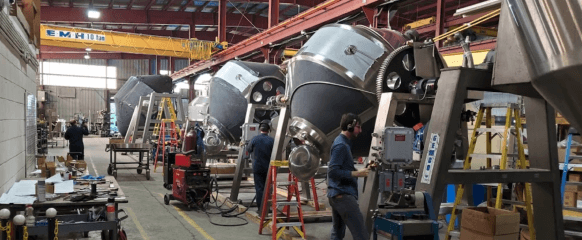GEMCO BLENDING FOR HIGH-PERFORMANCE THERMOPLASTICS
We take for granted the countless everyday items made of thermoplastics, from water bottles to the sturdy frames of our eyeglasses. But what gives these materials their strength, versatility, and consistent quality? The answer lies in a crucial step in the manufacturing process: tumble blending.
GEMCO’s affiliate company Advanced Powder Solutions (APS) had a client in the thermoplastics industry, facing challenges in achieving consistent color and efficient blending for their products.
In this blog post, we’ll delve into the challenges our client faced, how GEMCO’s blenders provided the perfect solution, and the valuable lessons learned throughout the process. We’ll explore how efficient blending is not just about getting the job done, but about creating a foundation for success.

Overcoming Blending Challenges
Thermoplastics are like the building blocks of our world, but for them to perform flawlessly, they need to be uniformly blended. Manufacturers require consistent color formulas and a precise mix of materials to achieve the desired properties. However, traditional blending methods often face hurdles such as:
- Low Yield: Recovering all the material during blending can be difficult, leading to higher production costs.
- Inconsistent Blending: Achieving a uniform mix across different batches can be a challenge.
- Limited Efficiency: Traditional blenders might not be suitable for all types of materials or require frequent reloading, slowing down production.
Efficient Blending and Sustainability
Thankfully, the industry is embracing new blending technologies that address these concerns. Here’s how GEMCO’s innovative solutions are making a positive impact:
- GEMCO blenders minimize material waste, leading to lower production costs and a more sustainable approach.
- Advanced technology ensures consistent and repeatable blending, guaranteeing product quality across batches.
- User-friendly blenders can handle a variety of materials and colors, streamlining the production process.
GEMCO machinery is specifically designed for these types of plastics: Polycarbonate, Polystyrene, Polypropylene, Acrylonitrile butadiene styrene, Polyester, Polyamide, Polythene, Acrylic.
Examples of Common Uses:
- ABS (Acrylonitrile Butadiene Styrene): Lightweight with high impact resistance and mechanical toughness. Used in toys, appliances, telephones, cell phones, microwaves, musical instruments, and safety hard hats.
- Acrylic (PMMA): Often used as a substitute for glass. Applications include motorcycle helmet visors, plane windows, aquariums, eyeglass lenses, and exterior lights for cars.
- Nylon: Used in heat-resistant materials. Commonly substitutes for silk in fabrics, ropes, musical instrument strings, flak Jackets or vests, parachutes, and women’s stockings.
- Polyethylene (PE): Used for water bottles, straws, apparel, luggage, and machinery components in automobiles and aircraft.
- Polypropylene (PP): Widely used due to its low cost, durability, and ease of assembly. Commonly found in construction materials.
- Polycarbonate: Known for its strength and transparency. Used in items like safety glasses, CDs, and medical devices.
Conclusion
The growing popularity of 3D printing and the increasing complexity of colors and materials demand innovative solutions. Blending plays a crucial role in additive manufacturing, allowing for the creation of complex objects with a variety of materials. It needs to be adaptable to handle the ever-evolving needs of the industry, accommodating new materials and processes. By embracing innovation and sustainability, the industry is poised to create the next generation of products we rely on every day.


